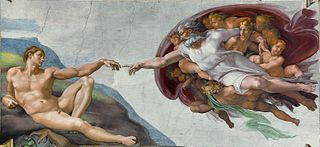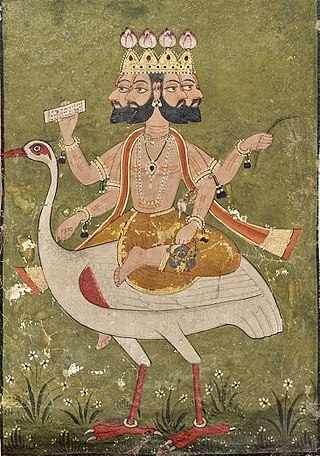
Creationism is the religious belief that nature, and aspects such as the universe, Earth, life, and humans, originated with supernatural acts of divine creation. In its broadest sense, creationism includes a continuum of religious views, which vary in their acceptance or rejection of scientific explanations such as evolution that describe the origin and development of natural phenomena.

Eschatology concerns expectations of the end of present age, human history, or the world itself. The end of the world or end times is predicted by several world religions, which teach that negative world events will reach a climax. Belief that the end of the world is imminent is known as apocalypticism, and over time has been held both by members of mainstream religions and by doomsday cults. In the context of mysticism, the term refers metaphorically to the end of ordinary reality and to reunion with the divine. Religions treat eschatology as a future event prophesied in sacred texts or in folklore. While other religions may have concepts of renewal or transformation after significant events, the explicit description of a new earth is primarily found in Christian teachings within the context of eschatology, this description can be found in Chapter 21 of the Book of Revelation.

Theism is broadly defined as the belief in the existence of at least one deity. In common parlance, or when contrasted with deism, the term often describes the philosophical conception of God that is found in classical theism—or conception found in monotheism—or gods found in polytheistic religions—or a belief in God or gods without the rejection of revelation as is characteristic of deism.
The wheel of time or wheel of history is a concept found in several religious traditions and philosophies, notably religions of Indian origin such as Hinduism, Jainism, Sikhism, and Buddhism, which regard time as cyclical and consisting of repeating ages. Many other cultures contain belief in a similar concept: notably, the Q'ero people of Peru, the Hopi people of Arizona, and the Bakongo people of Angola and Democratic Republic of the Congo.
A yuga, in Hinduism, is generally used to indicate an age of time.
The 32nd century BC was a century lasting from the year 3200 BC to 3101 BC.

Treta Yuga, in Hinduism, is the second and second-best of the four yugas in a Yuga Cycle, preceded by Krita (Satya) Yuga and followed by Dvapara Yuga. Treta Yuga lasts for 1,296,000 years.
Generally speaking, Buddhism is a religion that does not include the belief in a monotheistic creator deity. As such, it has often been described as either (non-materialistic) atheism or as nontheism, though these descriptions have been challenged by other scholars, since some forms of Buddhism do posit different kinds of transcendent, unborn, and unconditioned ultimate realities.

Satya Yuga, in Hinduism, is the first and best of the four yugas in a Yuga Cycle, preceded by Kali Yuga of the previous cycle and followed by Treta Yuga. Satya Yuga lasts for 1,728,000 years.

Linda Schele was an American Mesoamerican archaeologist who was an expert in the field of Maya epigraphy and iconography. She played an invaluable role in the decipherment of much of the Maya hieroglyphs. She produced a massive volume of drawings of stelae and inscriptions, which, following her wishes, are free for use to scholars. In 1978, she founded the annual Maya Meetings at The University of Texas at Austin.
Hindu cosmology is the description of the universe and its states of matter, cycles within time, physical structure, and effects on living entities according to Hindu texts. Hindu cosmology is also intertwined with the idea of a creator who allows the world to exist and take shape.

Pralaya is a concept in Hindu eschatology. Generally referring to four different phenomena, it is most commonly used to indicate the event of the dissolution of the entire universe that follows a kalpa called the Brahmapralaya.
The first Mandala ("book") of the Rigveda has 191 suktas which has 2006 hymns. Together with Mandala 10, it forms the latest part of the Rigveda. Its composition likely dates to the late Vedic period or the Early Iron Age.
A kalpa is a long period of time (aeon) in Hindu and Buddhist cosmology, generally between the creation and recreation of a world or universe.

The Mesoamerican Long Count calendar is a non-repeating base-20 and base-18 calendar used by several pre-Columbian Mesoamerican cultures, most notably the Maya. For this reason, it is often known as the MayaLong Count calendar. Using a modified vigesimal tally, the Long Count calendar identifies a day by counting the number of days passed since a mythical creation date that corresponds to August 11, 3114 BCE in the proleptic Gregorian calendar. The Long Count calendar was widely used on monuments.
Hindu units of time are described in Hindu texts ranging from microseconds to trillions of years, including cycles of cosmic time that repeat general events in Hindu cosmology. Time is described as eternal. Various fragments of time are described in the Vedas, Manusmriti, Bhagavata Purana, Vishnu Purana, Mahabharata, Surya Siddhanta etc.

Brahma is a Hindu god, referred to as "the Creator" within the Trimurti, the trinity of supreme divinity that includes Vishnu and Shiva. He is associated with creation, knowledge, and the Vedas. Brahma is prominently mentioned in creation legends. In some Puranas, he created himself in a golden embryo known as the Hiranyagarbha.

The 2012 phenomenon was a range of eschatological beliefs that cataclysmic or transformative events would occur on or around 21 December 2012. This date was regarded as the end-date of a 5,126-year-long cycle in the Mesoamerican Long Count calendar, and festivities took place on 21 December 2012 to commemorate the event in the countries that were part of the Maya civilization, with main events at Chichén Itzá in Mexico and Tikal in Guatemala.
Charles Taliaferro is an American philosopher specializing in theology and philosophy of religion.

Mahābrahmā, sometimes only called Brahma, is the ruler of the Brahma World (Brahmaloka) in the Buddhist cosmology. He is considered the protector of Buddhist teachings. Mahabrahma is generally represented in Buddhist culture as a god with four faces and four arms like other Brahmas, and variants of him are found in different Buddhist cultures. The Mahābrahmā, or the Great Brahma, is mentioned in Digha Nikaya as the being who dwells in the upper heaven; a Buddhist student can join him for one kalpa after successfully entering the first jhana in the form realm of Buddhist practice.








